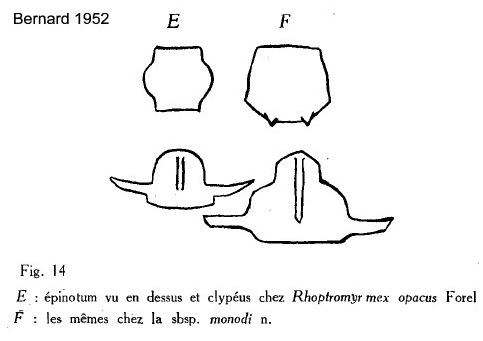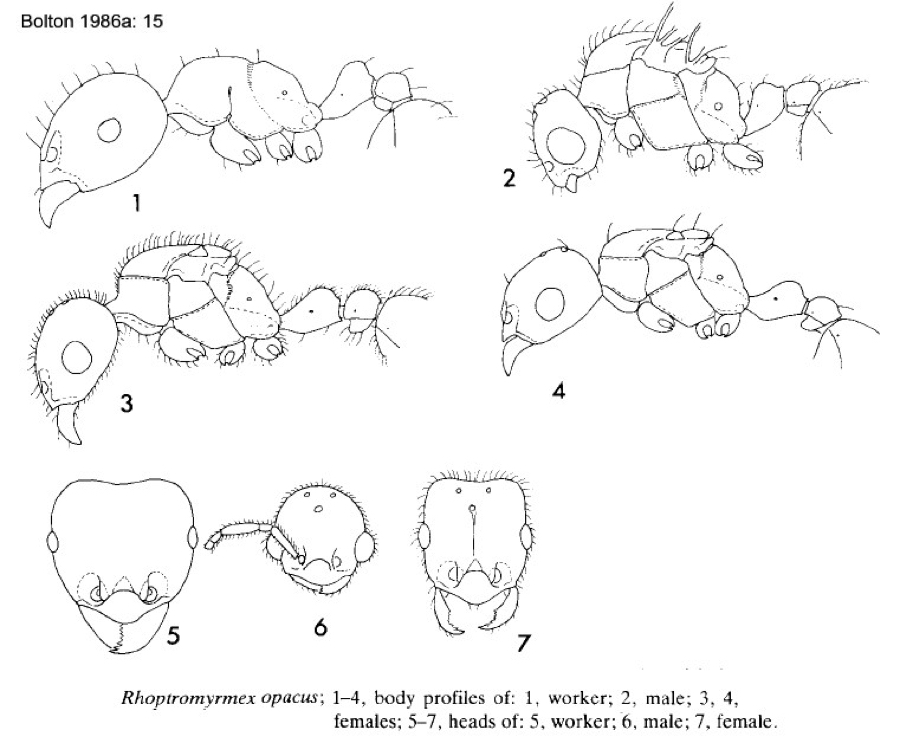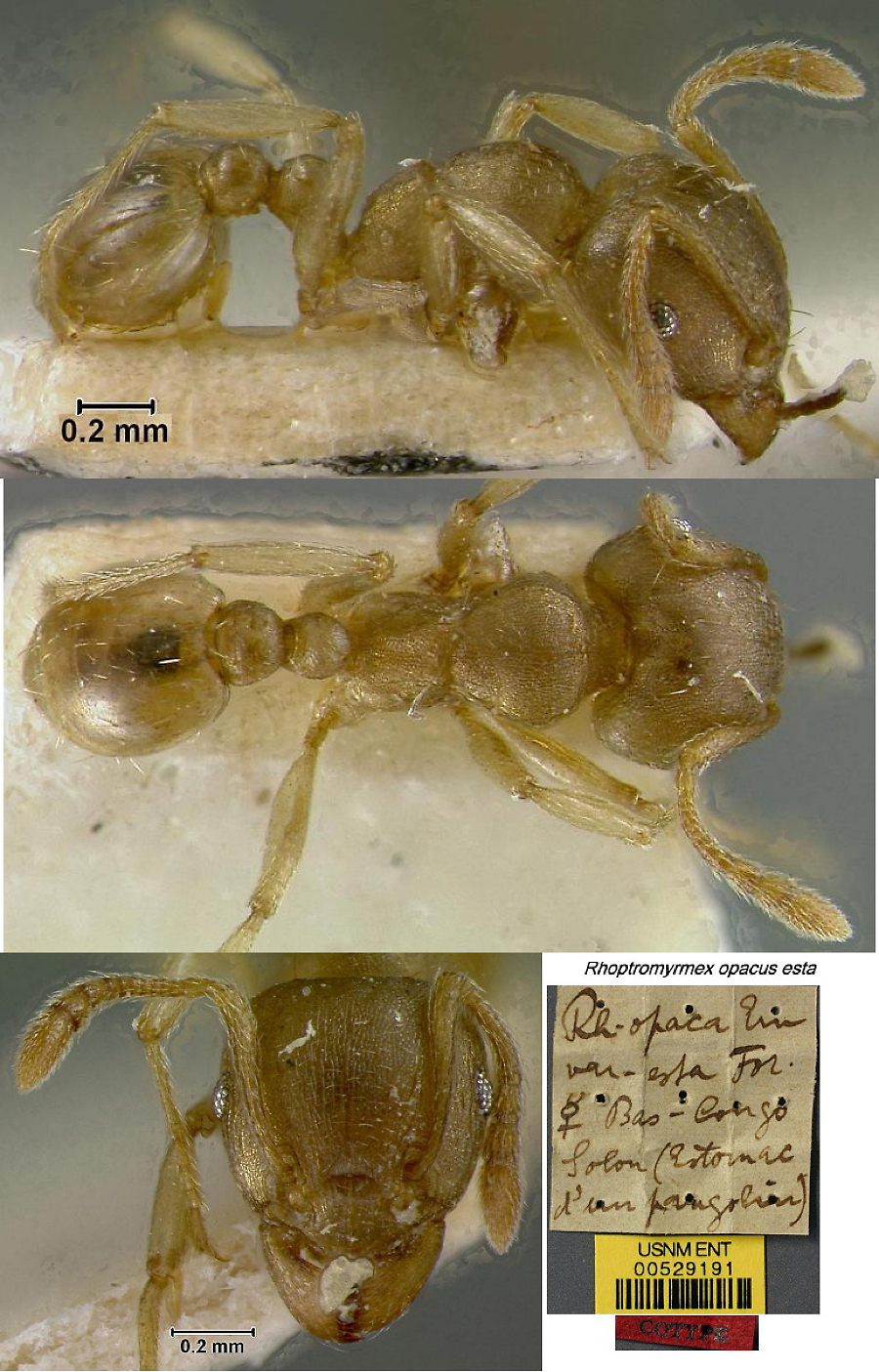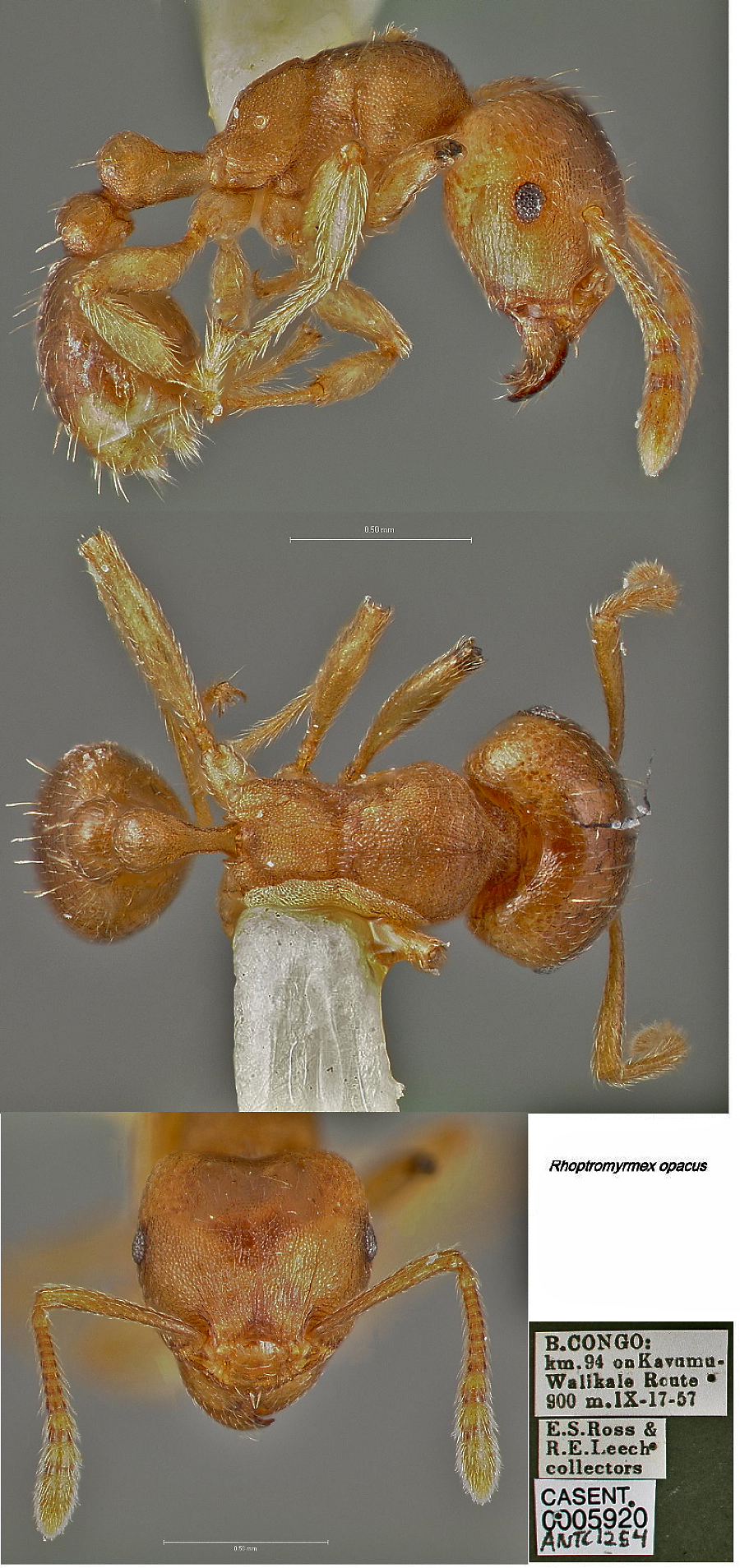Rhoptromyrmex opacus Emery
  Type location Cameroun
(Emery, in Forel, 1909b: 59, footnote, worker) collector L. Conradt - see http://www.antweb.org/specimenImages.do?code=casent0281190 Type location Cameroun
(Emery, in Forel, 1909b: 59, footnote, worker) collector L. Conradt - see http://www.antweb.org/specimenImages.do?code=casent0281190
junior synonyms
esta (Rhoptromyrmex
opacus Emery var. esta
n. var., Forel, 1909b: 59, all forms) from Zaïre - see below
laeviceps
(Rhoptromyrmex opacus Em. var.
laeviceps n. var.,
Santschi, 1916b: 504, worker) from Zaïre
collected at Boma, by Bondroit - see http://www.antweb.org/specimenImages.do?code=casent0913973
monodi (Rhoptromyrmex
opacus race monodi
n.sbsp., Bernard, 1952:
251,
illustrated, worker) from Guinea, one worker from Mt. Nimba,
Ziéla, station F 32, savannah, collector Lamotte - see http://www.antweb.org/specimenImages.do?code=casent0914275
all forms described
(see Bolton, 1995)  . .
|
 Emery's (1909b) description is at Emery's (1909b) description is at  . Forel's (1909b) description of esta
is at . Forel's (1909b) description of esta
is at  . Santschi's (1916b) description of laeviceps
is at . Santschi's (1916b) description of laeviceps
is at  . Bernard's (1952) description of monodi
is at . Bernard's (1952) description of monodi
is at  , epinotum = propodeum. , epinotum = propodeum.
Wheeler
(1922) described its collection in Zaïre by Bequaert, as nesting in
sandy soil in the savannah.
Bernard (1952) described his new subspecies monodi
as follows - TL 2.2 mm, length, striation, form of the head and of
petiole nodes, similar to the type opacus from Congo. Occiput
and thorax brown-black, face red-orange, clypeus yellow (orange in
type). Propodeum clearly angular in profle, with two dentiform ridges
on the posterior face, angled also on the sides (entirely rounded on
the sides in the type).
|
 Bolton's
modern description (1986a) is at Bolton's
modern description (1986a) is at  . .
WORKER - TL 2.5 mm; mandibles large, subopaque with 7-8
teeth, striato-punctate; head large and cordiform, as with transversinodis
and globulinodis but shorter and wider, sides
very convex; more pronounced forwards, clypeus subcarinate and forming
a rounded lobe. Scape reaching posterior sixth of head; funiculus
segments 2-8 narrower than long. Metanotal groove distinct (missing on
Mayr species). Petiole pedicel short (longer in Mayr species); node
rounded cuboid, slightly wider than long; postpetiole node bigger, but
no higher. With twelve-segmented antennae; the head and alitrunk
usually with dense, opaque reticulate-punctate sculpture; propodeum
unarmed; head and gaster always with standing hairs, but not always so
on the alitrunk. Colour darkish yellow, head and thorax reddish.
(Emery, in Forel, 1909b: 59, footnote, worker; Bolton, 1976, not
illustrated; Bolton, 1986, fully illustrated).
|
 Forel
(1909b) described esta as having a smaller head, somewhat
longer than wide, sides less convex and without a medina carina on the
clypeus; otherwise similar although shoulders of pronotum more rounded.
He also described the queen and male. All the specimens came from the
stomach of a Pangolin in Bas Congo, collected by Solon. The latter was
referred to by Santschi (1916b) who described laeviceps as
differing in having less obvious sculpturation and being shinier. Forel
(1909b) described esta as having a smaller head, somewhat
longer than wide, sides less convex and without a medina carina on the
clypeus; otherwise similar although shoulders of pronotum more rounded.
He also described the queen and male. All the specimens came from the
stomach of a Pangolin in Bas Congo, collected by Solon. The latter was
referred to by Santschi (1916b) who described laeviceps as
differing in having less obvious sculpturation and being shinier.
The photomontage of a cotype of esta is collated
from The Smithsonian Institute images at http://ripley.si.edu/ent/nmnhtypedb/public/specimeninfopage.cfm?publicconsumption=1&typespecimenID=1357.
|
 The
photomontage is collated from http://www.antweb.org/specimen.do?name=casent0005920 The
photomontage is collated from http://www.antweb.org/specimen.do?name=casent0005920
Collection details - Congo: ; km. 94 on Kavumu Walikale route;
00°00'00"N 000°00'00"E, 900m. Collection Information: Collection codes:
ANTC1254. Date: 17 Sep 1957. Collected by: E. S. Ross & R. E. Leech
.
: |
Oxford University Museum
specimens
Rhoptromyrmex opacus
B Taylor det.
|
Cameroun
A Fotso Kuate
Sample 19
|
3.ix.2008
Babedjou
03°54'30" N
11°25'58" E
|
Aphid survey
|
2
|
 |
Rhoptromyrmex opacus
B Taylor det. |
Congo
E Zassi
01-t-1
|
4-5.ii.2008
Lésio-Louna
03°20'12.0" S
015°28'43.6" E
|
Village Mah; 24h
pitfall trap
|
1
|
 |
|
 The
photomontage is of a worker from Congo, Réserve de Lésio-Louna;
collector Eric Zassi (pitfall trap 01, t 1) The
photomontage is of a worker from Congo, Réserve de Lésio-Louna;
collector Eric Zassi (pitfall trap 01, t 1)
|
 The photomontage is of
a specimen from Cameroun; Babedjou; collector A
Fotso Kuate (fk unmounted 19). The photomontage is of
a specimen from Cameroun; Babedjou; collector A
Fotso Kuate (fk unmounted 19).
|
|